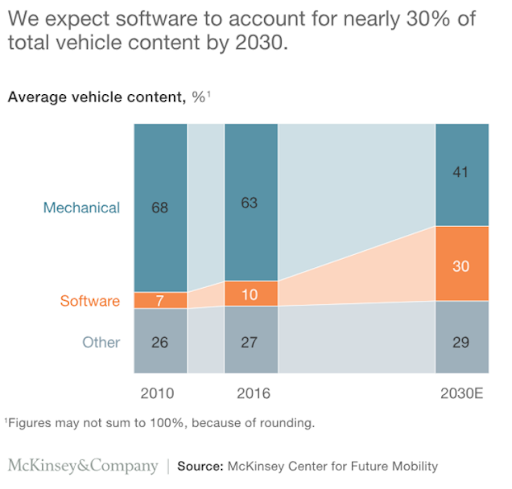Electrifying Software and Controls Engineering Insights
Looking ahead into the 2020s, uncertainty is high on many fronts. Technological change is disrupting businesses and bringing new social, regulatory, and ecological questions to the forefront. Electrification & Autonomous Drive are key challenges for Automotive.

Growing software content in automotive
While we know that electrification is an imperative for automakers, we also know that more and more focus is going to be on the software content.
The industry is shifting its focus from a hardware-driven product to a software-driven product. Indeed, the role of software has increased and will continue to grow dramatically; according to a McKinsey report, software will account for 30 percent of total vehicle content by 2030, up from about 10 percent today.
Gone are the days when engineering the vehicle software was limited to silos. Engineering the needed software for the vehicles has expanded beyond the vehicle itself and requires extreme collaboration across many domains and organizations to deliver newer up-coming features like Mobility, Autonomous Driving, Electrification, over-the-cloud updates and many more.
Gone are the days when engineering the vehicle software was limited to silos. Engineering the needed software for the vehicles has expanded beyond the vehicle itself and requires extreme collaboration across many domains and organizations to deliver newer up-coming features like Mobility, Autonomous Driving, Electrification, over-the-cloud updates and many more.

Frontloading of verification and validation gets more and more importance
This transition has a huge impact on the automotive industry as we know it today and it only stresses the importance of good verification and validation process and workflow which can identify issues at the time when they are introduced.
This comes on top of the existing challenges of today’s vehicle development programs, like energy efficiency, performance, comfort, and all this while developing vehicles at a reasonable cost. These items get even more important when your vehicles are operated in a multitude of scenarios across the globe.
Model-Based Systems Engineering (MBSE) provides an approach to engineering where system architecture takes the center stage to support system requirements, design, analysis and verification and validation activities.
Companies are going through this on-going challenge to establish an optimized, adaptive, resilient and end-to-end traceable product development platform that can adapt to current technology needs as well as future ones while also keeping safety and security at its forefront.
A while ago I had delivered a short 30-minute webinar to highlight what Siemens Digital Industries Software can bring to you when it comes to successfully tackling software and controls engineering issues of xEV’s. I bring some more electrifying insights from Siemens on below topics along with an overview on how we have worked with leading automotive OEMs and suppliers across the globe. You can watch it here or by clicking below link.

 Deutsch (Deutschland)
Deutsch (Deutschland)  English (UK)
English (UK) 


